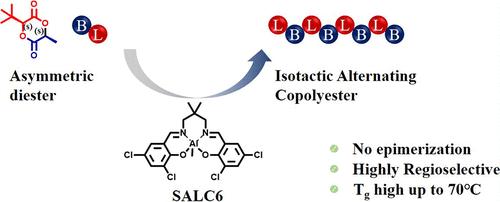不对称二酯的高区域选择性开环聚合
IF 5.2
1区 化学
Q1 POLYMER SCIENCE
引用次数: 0
摘要
控制羟基酸共聚物的单体序列仍然是一个重大挑战,但它是微调共聚酯性能的必要条件。本文研究了l-3-叔丁基-6-甲基-1,4-二恶烷-2,5-二酮(l-tBMG)的区域选择性开环聚合(ROP),合成了交替聚乳酸-co-2-叔丁基乙醇酸共聚物。对映体纯希夫碱铝催化剂具有二萘基框架或2,2-二甲基丙二胺和3,5-二氯水杨醛框架。这些催化剂促进了不对称环二酯的区域选择性开环,特别是在乳酸部分的酰基氧键上。通过异核多键相关光谱分析了所得聚合物的分子链结构,并用1H NMR和定量13C NMR (q-13C NMR)评价了链的规律性。根据1H NMR和q-13C NMR测试结果,分子链正则性约为0.93。2-叔丁基羟基乙酸单元的加入导致无规共聚物的玻璃化转变温度(Tg)达到65℃。值得注意的是,在上述催化剂的催化下,通过ROP合成的等规聚合物的Tg进一步提高到70℃。本文章由计算机程序翻译,如有差异,请以英文原文为准。

Highly Regioselective Ring-Opening Polymerization of an Asymmetric Diester
Controlling the monomer sequence in hydroxy acid copolymers remains a significant challenge, yet it is essential for fine-tuning the properties of copolyesters. This study presents the regioselective ring-opening polymerization (ROP) of l-3-tert-butyl-6-methyl-1,4-dioxane-2,5-dione (l-tBMG), resulting in the synthesis of alternating polylactic acid-co-2-tert-butylglycolic acid copolymers. The process is facilitated by enantiomerically pure Schiff base aluminum catalysts featuring either a binaphthyl framework or a 2,2-dimethylpropylenediamine and 3,5-dichlorosalicylaldehyde framework. These catalysts promote regioselective ring-opening of the asymmetric cyclic diester specifically at the acyl-oxygen bond of the lactic acid moiety. The molecular chain structure of the resulting polymers was elucidated through heteronuclear multiple bond correlation spectroscopy, while chain regularity was assessed using 1H NMR and quantitative 13C NMR (q-13C NMR). According to the 1H NMR and q-13C NMR test results, the molecular chain regularity is about 0.93. Incorporation of 2-tert-butylglycolic acid units led to a glass transition temperature (Tg) of the random copolymer to 65 °C. Notably, the Tg of the isotactic polymer, synthesized via ROP catalyzed by the aforementioned catalysts, was further elevated to 70 °C.
求助全文
通过发布文献求助,成功后即可免费获取论文全文。
去求助
来源期刊

Macromolecules
工程技术-高分子科学
CiteScore
9.30
自引率
16.40%
发文量
942
审稿时长
2 months
期刊介绍:
Macromolecules publishes original, fundamental, and impactful research on all aspects of polymer science. Topics of interest include synthesis (e.g., controlled polymerizations, polymerization catalysis, post polymerization modification, new monomer structures and polymer architectures, and polymerization mechanisms/kinetics analysis); phase behavior, thermodynamics, dynamic, and ordering/disordering phenomena (e.g., self-assembly, gelation, crystallization, solution/melt/solid-state characteristics); structure and properties (e.g., mechanical and rheological properties, surface/interfacial characteristics, electronic and transport properties); new state of the art characterization (e.g., spectroscopy, scattering, microscopy, rheology), simulation (e.g., Monte Carlo, molecular dynamics, multi-scale/coarse-grained modeling), and theoretical methods. Renewable/sustainable polymers, polymer networks, responsive polymers, electro-, magneto- and opto-active macromolecules, inorganic polymers, charge-transporting polymers (ion-containing, semiconducting, and conducting), nanostructured polymers, and polymer composites are also of interest. Typical papers published in Macromolecules showcase important and innovative concepts, experimental methods/observations, and theoretical/computational approaches that demonstrate a fundamental advance in the understanding of polymers.
 求助内容:
求助内容: 应助结果提醒方式:
应助结果提醒方式:


